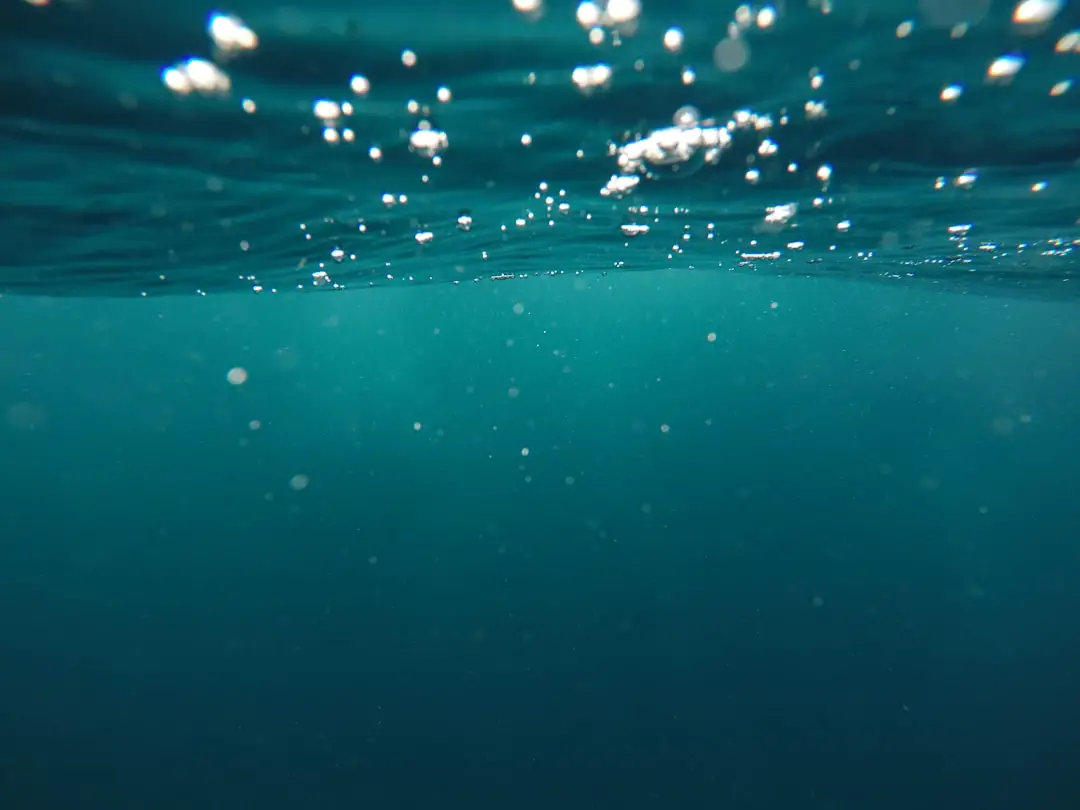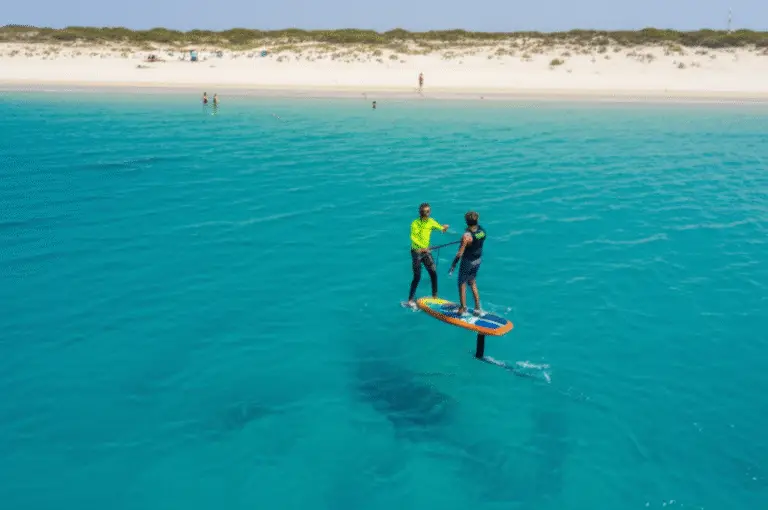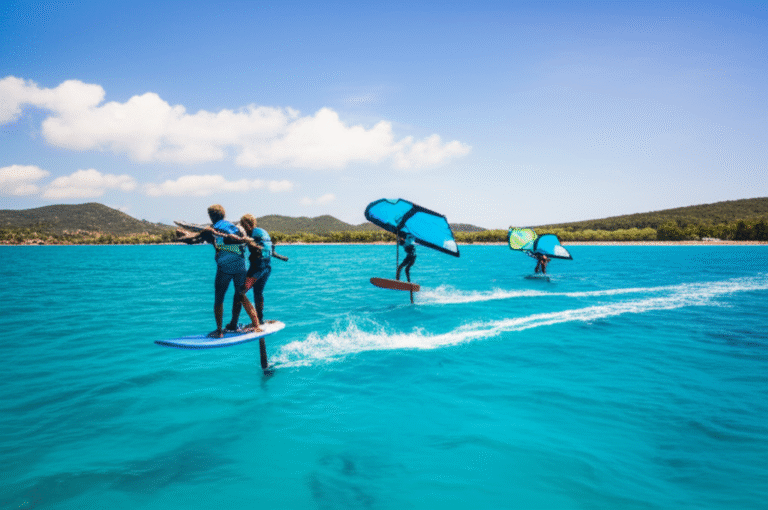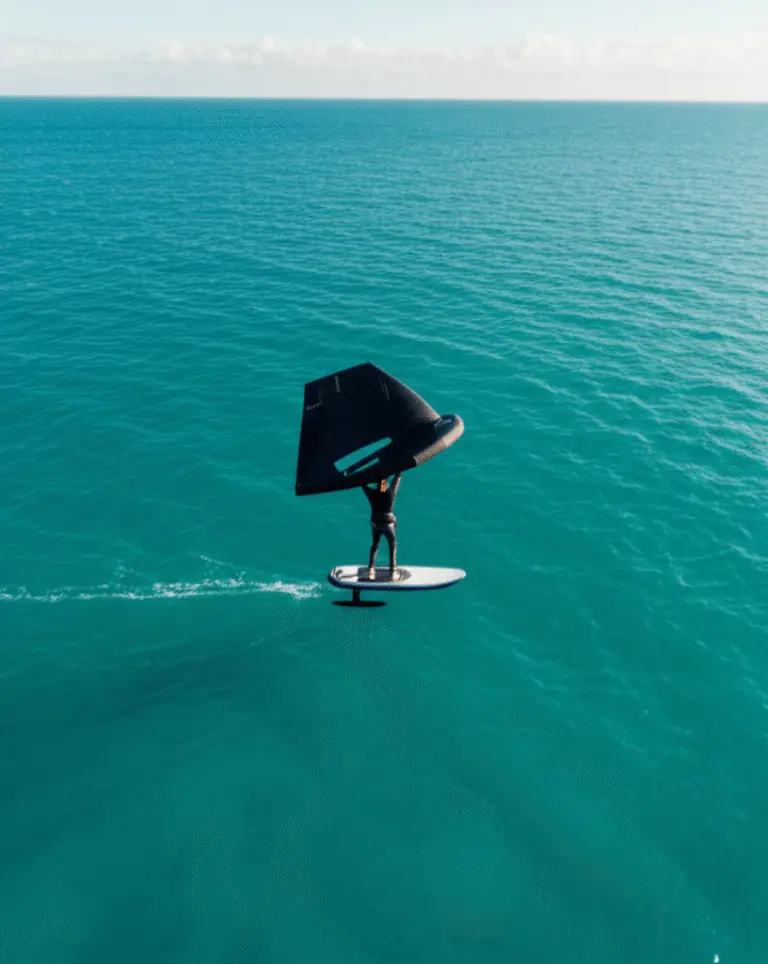Support our hydrofoil educational content for free when you purchase through links on our site. Learn more
8 Essential Skills & Techniques to Master Hydrofoil Boarding in 2025 🏄♂️
Last week, one of our Hydrofoiling™ coaches finally took the plunge into the mysterious world of hydrofoil boarding — that magical sport where you literally fly above the water. He was warned about the infamous wipeouts, the tricky balance, and the long walks back to shore with foil in hand. But to his surprise, after mastering just a few key skills, he was cruising back upwind with a grin from ear to ear. Curious how he did it? Well, you’re in luck, because we’re about to reveal the 8 essential skills and techniques every beginner needs to learn hydrofoil boarding confidently and safely in 2025.
Did you know that the average beginner foil wing size is around 200-250 cm², providing the perfect balance of lift and stability? Or that keeping your weight forward and knees bent can drastically reduce wipeouts? Whether you’re a surfer, kiteboarder, or SUP enthusiast, this guide will walk you through everything from gear selection to advanced balance tips — all backed by real stories, expert advice, and detailed step-by-step instructions. Ready to fly?
Key Takeaways
- Master balance and weight distribution by keeping your weight forward and knees bent to maintain foil stability.
- Start with beginner-friendly gear like the Slingshot Hover Glide board and Lift Foils 200 Wing for easier lift and control.
- Practice foundational skills on flat water or a surfboard before attempting full hydrofoil flights.
- Embrace wipeouts as learning moments and always wear safety gear like helmets and impact vests.
- Progress through advanced techniques such as pumping, carving, and riding in choppy conditions once basics are solid.
Ready to gear up?
- 👉 Shop Slingshot Hover Glide boards: Amazon | Slingshot Official
- Explore Lift Foils wings: Amazon | Lift Foils Official
- Find quality foot straps: Amazon | Dakine Official
Dive in and discover how you can transform from a nervous beginner into a confident hydrofoil flyer!
Table of Contents
- ⚡️ Quick Tips and Facts for Beginner Hydrofoil Boarding
- 🌊 The Rise of Hydrofoil Boarding: A Beginner’s Journey into Foil Surfing
- 1. Essential Skills You Need to Master Before Hydrofoil Boarding
- 2. Step-by-Step Techniques to Get Started with Hydrofoil Boarding
- 3. Balancing Like a Pro: Tips to Find Your Foilboarding Zen
- 4. How to Handle Common Challenges and Avoid Wipeouts
- 5. Choosing the Right Hydrofoil Gear and Setup for Beginners
- 6. Advanced Techniques to Progress Beyond the Basics
- 7. Safety First: Essential Precautions and Best Practices
- 8. Real Stories from First-Time Hydrofoilers: What We Learned
- Conclusion: Your Path to Hydrofoil Boarding Mastery
- Recommended Links for Hydrofoil Boarding Enthusiasts
- FAQ: Your Burning Questions About Hydrofoil Boarding Answered
- Reference Links and Resources for Further Learning
⚡️ Quick Tips and Facts for Beginner Hydrofoil Boarding
Welcome to the thrilling world of hydrofoil boarding! If you’re just starting out, you might feel like you’re about to ride a flying carpet over water — and in a way, you are. But before you get airborne, here are some quick tips and facts to set you up for success:
Quick Tips from Hydrofoiling™ Experts
- Start with the basics: Learn to control your board on flat water before attempting to lift off. This means mastering weight distribution and balance.
- Keep your weight forward: Shifting your weight back too much causes the foil to rise uncontrollably and can lead to wipeouts.
- Bend those knees: You can never get low enough! A low center of gravity is your best friend.
- Use foot straps wisely: Front foot strap placement is crucial; beginners often leave the back strap off for easier dismounts.
- Practice on a surfboard first: This helps you get comfortable with stance and balance without the harsh crashes of a foilboard.
- Wear safety gear: Helmets and impact vests are highly recommended — foilboards have sharp edges and can be unforgiving.
Fascinating Facts to Keep in Mind
| Fact | Detail |
|---|---|
| Average learning wind speed | 10-15 knots is ideal for beginners to get comfortable without overpowering the foil. |
| Common beginner foil size | Larger foils (around 200-250 cm² wing area) provide more lift and stability. |
| Most frequent cause of wipeouts | Leaning too far back or sudden weight shifts causing the foil to pitch up or dive. |
| Recommended board volume for beginners | 110-130 liters for stability and easier paddling (especially for kite foiling). |
For a deeper dive into what hydrofoiling is all about, check out our What is hydrofoiling explained? article.
🌊 The Rise of Hydrofoil Boarding: A Beginner’s Journey into Foil Surfing
Hydrofoil boarding has exploded in popularity over the last decade, transforming the way we experience water sports. Imagine gliding silently above the water’s surface, the board seemingly floating on air — that’s the magic of hydrofoiling. But how did this all start?
A Brief Look at Hydrofoil Boarding’s Evolution
- Origins: The hydrofoil concept dates back to the early 1900s, but it wasn’t until the 2000s that hydrofoil boards became accessible to surfers and kiteboarders.
- Technological Advances: Carbon fiber masts, lightweight fuselages, and modular designs from brands like Lift Foils and Slingshot Sports have made foiling more approachable.
- Community Growth: Online forums and social media groups have accelerated knowledge sharing, making it easier for beginners to find tips and gear recommendations.
Why Beginners Are Hooked
- Smooth Ride: Foiling reduces chop and bumpiness, making for a smoother experience even in less-than-perfect conditions.
- Efficiency: Hydrofoils require less wind or wave power to get moving, opening up more days on the water.
- Challenge & Reward: The learning curve is steep but mastering hydrofoiling feels like unlocking a secret water sport superpower.
Curious about the history and technical background? Visit our Hydrofoil History section for a detailed timeline and tech insights.
1. Essential Skills You Need to Master Before Hydrofoil Boarding
Before you take off on your foilboard, there are key foundational skills you need to nail down. These will save you from frustration and help you progress faster.
Balance and Weight Distribution
- Why it matters: Hydrofoils respond dramatically to weight shifts. Too far back, and you’ll pitch up and stall; too far forward, and you’ll nosedive.
- How to practice: Spend time on a regular surfboard or SUP practicing keeping your weight centered and slightly forward.
Body Positioning and Stance
- Knees bent, body low: This lowers your center of gravity and improves control.
- Hands on the bar (for kite foiling): Keep both hands on the kite bar to maintain control and react quickly.
Reading Water Conditions
- Spotting bumps and waves: Look ahead and to the sides to anticipate water surface changes. This helps you time your foil lift and maintain stability.
- Wind awareness: For kite foilers, understanding wind direction and power zones is crucial.
Paddling Technique (For SUP Foilers)
- J-stroke: This stroke helps you paddle straight and efficiently.
- Short, sharp strokes: Build speed without exhausting yourself.
Mental Preparedness
- Expect falls: Wipeouts are part of the learning process. Embrace them as lessons, not failures.
- Patience is key: Hydrofoil boarding is a marathon, not a sprint.
For more on these basics, check out our Hydrofoil Basics category.
2. Step-by-Step Techniques to Get Started with Hydrofoil Boarding
Ready to get your feet wet? Here’s a detailed, step-by-step guide to your first hydrofoil boarding sessions.
Step 1: Gear Setup and Safety Check
- Choose the right foil: Start with a large, stable foil like the Lift Foils 200 Wing or Slingshot Hover Glide.
- Adjust mast position: Move the mast slightly forward in the board tracks to prevent nose dives.
- Foot strap placement: Front foot strap as far forward as possible; consider skipping the back strap initially.
- Safety gear: Helmet, impact vest, and leash are non-negotiable.
Step 2: Waterstart and Getting Comfortable
- Start in shallow water: Practice standing up on the board without the foil lifting.
- Weight forward: Keep your weight centered over the front foot to keep the foil submerged.
- Kite control (if kite foiling): Keep the kite at 45 degrees to the wind to maintain steady pull.
Step 3: Foil Lift-Off
- Build speed: Paddle or kite power up to a speed where the foil starts to generate lift.
- Shift weight carefully: Slightly lean forward to initiate lift without pitching the nose down.
- Small leg pumps: Use subtle leg movements to maintain lift and balance.
Step 4: Maintaining Flight
- Micro-adjustments: Use subtle weight shifts to control altitude and direction.
- Look ahead: Anticipate bumps and adjust your stance accordingly.
- Keep knees bent: Stay relaxed and ready to absorb changes.
Step 5: Controlled Landing and Dismount
- Slow down gradually: Reduce speed to bring the foil back into the water smoothly.
- Step off safely: Practice controlled dismounts to avoid injury or board damage.
3. Balancing Like a Pro: Tips to Find Your Foilboarding Zen
Balance is the holy grail of hydrofoil boarding. Here’s how to find your groove and stay upright longer.
The Weight Forward Secret
- Why it works: Keeping your weight over the front foot keeps the foil submerged and stable.
- How to feel it: Imagine pressing down on the front of the board like you’re trying to keep the nose from popping up.
Knee Bend and Body Relaxation
- Flexibility is key: Locked knees lead to stiff reactions and wipeouts.
- Stay loose: Think of your legs as shock absorbers.
Foot Placement and Strap Use
| Foot Strap Setup | Pros | Cons |
|---|---|---|
| Front strap only | Easier to bail, more freedom | Less control on turns |
| Both straps | Better board control | Harder to dismount quickly |
| No straps | Maximum freedom, natural feel | Risk of board slipping away |
Practice Balance Drills
- On land: Balance on a wobble board or skateboard to train proprioception.
- On water: Start on calm days and practice gliding without lifting the foil.
Anecdote from Hydrofoiling™ Team
“When I first started, I kept leaning back instinctively — every time I did, the foil popped up and I faceplanted. Once I learned to keep my weight forward and bend my knees, it was like night and day. Suddenly, I was flying instead of falling!” — Jake, Hydrofoiling™ Coach
4. How to Handle Common Challenges and Avoid Wipeouts
Wipeouts are inevitable, but you can minimize them by understanding common pitfalls.
Common Challenges
- Nose dives: Caused by leaning too far forward or sudden weight shifts.
- Pitching up: Leaning too far back causes the foil to stall and flip backward.
- Loss of balance on choppy water: Waves and bumps can throw off your center of gravity.
How to Avoid Them
- Smooth weight shifts: Avoid sudden movements; think “slow and steady.”
- Keep eyes forward: Anticipate water surface changes.
- Adjust mast and foil setup: Beginners benefit from longer masts and bigger wings for stability.
Controlled Crash Techniques
- Bail safely: Let go of the board and kite (if kite foiling) to avoid injury.
- Stay upwind: Try to fall upwind of your gear to prevent it from drifting away.
- Practice waterstarts: Getting back on the board quickly reduces frustration.
Safety Gear Reminder
- Helmets and impact vests can prevent serious injuries during wipeouts.
For more on safety and crash techniques, visit our Hydrofoil Equipment Reviews and Advanced Hydrofoiling Techniques sections.
5. Choosing the Right Hydrofoil Gear and Setup for Beginners
Gear choice can make or break your first hydrofoil experience. Here’s how to pick the best setup.
Beginner-Friendly Hydrofoil Boards
| Brand & Model | Volume (Liters) | Length (Feet) | Stability Rating (1-10) | Notes |
|---|---|---|---|---|
| Slingshot Hover Glide | 120 | 5’6” | 9 | Stable, durable, great for beginners |
| Lift Foils Surfer 5’8” | 110 | 5’8” | 8 | Lightweight carbon build |
| Naish Thrust 5’10” | 130 | 5’10” | 9 | High volume, easy to paddle |
Foil Wing Size and Mast Length
- Wing size: Larger wings (200-250 cm²) provide more lift and stability.
- Mast length: Beginners benefit from 70-80 cm masts for better clearance and control.
Foot Straps and Pads
- Comfortable, adjustable foot straps help maintain control without restricting movement.
- Brands like Dakine and Slingshot offer quality options.
Kite and Paddle Recommendations
- Kite foilers: Use stable, easy-to-control kites like the North Neo or Cabrinha Switchblade.
- SUP foilers: Adjustable paddles like the Werner Shuna help find your perfect length.
Hydrofoil Gear Ratings Table (1-10 scale)
| Aspect | Slingshot Hover Glide | Lift Foils Surfer | Naish Thrust |
|---|---|---|---|
| Design | 9 | 9 | 8 |
| Stability | 9 | 8 | 9 |
| Durability | 8 | 7 | 8 |
| Ease of Use | 9 | 8 | 8 |
| Value for Money | 8 | 7 | 8 |
6. Advanced Techniques to Progress Beyond the Basics
Once you’ve mastered the fundamentals, it’s time to level up your hydrofoil boarding skills.
Pumping to Generate Speed
- Use subtle leg pumps to maintain lift without relying solely on wind or waves.
- Timing your pumps with paddle strokes (for SUP foilers) increases efficiency.
Carving and Turning
- Shift weight smoothly from toe to heel to initiate turns.
- Use your hips and shoulders to guide the board’s direction.
Riding in Choppy Conditions
- Anticipate bumps by looking ahead and adjusting your stance.
- Keep your knees bent and body relaxed to absorb shocks.
Downwind Runs and Long Distance Foiling
- Learn to read wind and wave patterns for efficient downwind travel.
- Practice pacing and energy management to avoid fatigue.
For detailed tutorials, visit our Advanced Hydrofoiling Techniques section.
7. Safety First: Essential Precautions and Best Practices
Hydrofoil boarding is exhilarating but comes with risks. Here’s how to stay safe:
Must-Have Safety Gear
- Helmet: Protects your head from foil blades and hard falls.
- Impact vest: Provides flotation and padding.
- Leash: Keeps your board close but choose a quick-release leash to avoid entanglement.
Environmental Awareness
- Avoid crowded spots to reduce collision risk.
- Check weather and water conditions before heading out.
Emergency Procedures
- Practice controlled crashes and quick waterstarts.
- Know how to release your kite quickly if kite foiling.
Buddy System
- Always foil with a friend or group for assistance in emergencies.
8. Real Stories from First-Time Hydrofoilers: What We Learned
Nothing beats learning from real experiences. Here are some stories from our Hydrofoiling™ team and community:
Jake’s First Flight
“I was terrified of falling, but once I got the hang of weight distribution, I was flying for minutes! The key was patience and not rushing the lift-off.”
Sarah’s Gear Revelation
“Starting with a big foil and a stable board made all the difference. I tried a smaller foil first and kept wiping out. Upgrading to a Lift Foils 200 Wing was a game changer.”
Community Wisdom
- Beginners who practice on surfboards first tend to progress faster.
- Learning with a buddy keeps motivation high and safety in check.
Want more inspiring stories and tips? Check out our Hydrofoil Board Selection category.
Conclusion: Your Path to Hydrofoil Boarding Mastery

Congratulations! You’ve just unlocked the ultimate beginner’s guide to hydrofoil boarding — from the essential skills and techniques to gear choices and safety tips. Remember, hydrofoiling is as much a mental game as a physical one. Patience, persistence, and a willingness to embrace wipeouts will turn those early tumbles into smooth, soaring rides.
Wrapping Up the Essentials
- Keep your weight forward and knees bent — this simple mantra will save you from most wipeouts.
- Start with stable, beginner-friendly gear like the Slingshot Hover Glide board paired with a larger foil wing (200-250 cm²).
- Practice balance and body positioning on a surfboard first to build confidence without the harsh consequences of foil crashes.
- Safety gear is non-negotiable — helmets, impact vests, and quick-release leashes keep you protected.
- Learn with a buddy — it’s safer, more fun, and you’ll progress faster with shared feedback.
Product Summary & Recommendation
If you’re wondering which gear to start with, here’s the lowdown on the Slingshot Hover Glide and Lift Foils 200 Wing combo that many beginners rave about:
| Pros ✅ | Cons ❌ |
|---|---|
| Highly stable and forgiving design | Slightly heavier than ultra-light models |
| Durable construction for rough learning | Price point may be higher for casual users |
| Excellent lift and smooth ride | Requires some assembly and tuning |
Our confident recommendation: Invest in a stable, larger-wing foil setup like the Lift Foils 200 Wing paired with a beginner-friendly board such as the Slingshot Hover Glide. This combo balances ease of use, durability, and performance — perfect for your first flights and beyond.
Now that you’re armed with knowledge, gear tips, and insider tricks, it’s time to hit the water and experience the magic of hydrofoil boarding yourself. Remember Jake’s story — those first flights are unforgettable, and with the right mindset, you’ll be cruising like a pro in no time!
Recommended Links for Hydrofoil Boarding Enthusiasts
Ready to gear up or deepen your knowledge? Check out these trusted products and resources:
-
Slingshot Hover Glide Board:
Amazon | Slingshot Official Website -
Lift Foils 200 Wing:
Amazon | Lift Foils Official Website -
Dakine Foot Straps:
Amazon | Dakine Official Website -
North Neo Kite:
Amazon | North Kites Official Website -
Werner Shuna Adjustable Paddle:
Amazon | Werner Paddles Official Website -
Recommended Reading:
“Hydrofoil Surfing: The Complete Guide” by Mike Howard — Amazon Link
“Kiteboarding: The Complete Guide” by Aaron Hadlow — Amazon Link
FAQ: Your Burning Questions About Hydrofoil Boarding Answered

What are the essential safety precautions to consider when learning hydrofoil boarding for the first time?
Safety is paramount when learning hydrofoil boarding. Start by wearing a helmet and impact vest to protect against falls and collisions with the sharp foil edges. Use a quick-release leash to avoid entanglement. Always check weather and water conditions before heading out, avoiding crowded areas to reduce collision risk. Practice controlled crashes and waterstarts in shallow water before venturing into deeper zones. Finally, never foil alone — having a buddy ensures help is nearby if needed.
Read more about “How to Hydrofoil Behind a Boat: 7 Essential Tips! 🚤”
How long does it typically take for a beginner to learn the basics of hydrofoil boarding and become proficient?
Learning time varies widely depending on prior water sports experience, physical fitness, and practice frequency. For most beginners, expect several sessions over a few weeks to grasp basic balance, lift-off, and controlled flight. Those with surfing or kiteboarding backgrounds may progress faster. Consistency is key — short, focused sessions with proper instruction accelerate learning. Remember, hydrofoiling is a skill that improves over months, with mastery taking years.
What kind of physical conditioning and strength is required to participate in hydrofoil boarding, and how can I prepare myself?
Hydrofoil boarding demands core strength, balance, leg endurance, and cardiovascular fitness. Your legs act as shock absorbers, knees bent to maintain stability. Core muscles stabilize your torso during weight shifts. To prepare, incorporate balance training (e.g., wobble boards), leg strengthening exercises (squats, lunges), and cardio workouts (running, cycling). Flexibility and proprioception drills also help reduce injury risk and improve control.
Are there any specific types of hydrofoil boards or equipment that are recommended for beginners, and what features should I look for when making a purchase?
Beginners should look for boards with high volume (110-130 liters) and longer length (5’6” to 6’0”) for stability and easier paddling. Larger foil wings (200-250 cm²) provide more lift and smoother rides. Masts around 70-80 cm offer good clearance and control. Foot straps should be adjustable and comfortable, with many beginners opting to skip the back strap initially for easier dismounts. Brands like Slingshot, Lift Foils, and Naish offer excellent beginner-friendly setups. Prioritize durability and ease of use over ultra-lightweight gear at first.
How can I effectively practice hydrofoil boarding if I don’t have access to waves or strong wind?
Great question! You can practice balance, stance, and paddling technique on flat water using a SUP foilboard or a stable surfboard. Many beginners start on lakes or calm bays where wind or wave power is minimal. Using an electric foilboard (e-foil) is another option for controlled practice without relying on natural elements. Additionally, land-based balance training and visualization techniques help build muscle memory before hitting the water.
What are the best ways to recover quickly from falls and minimize injury during hydrofoil boarding?
Falling is part of the learning curve. To minimize injury, always fall away from the board and foil, keeping your limbs tucked to avoid hitting the sharp edges. Practice controlled bail techniques — releasing the kite (if kite foiling) and pushing the board away from your body. Wearing protective gear like helmets and impact vests greatly reduces injury risk. After falls, take a moment to breathe, assess your gear, and get back on with a positive mindset.
Reference Links and Resources for Further Learning
- Lift Foils Official Website — Explore their range of foils and wings.
- Slingshot Sports Official Website — Boards and accessories for hydrofoiling.
- North Kites Official Website — Trusted kiteboarding gear.
- Werner Paddles Official Website — Adjustable paddles for SUP foiling.
- Dakine Foot Straps — Quality foot straps for board control.
- Josh Ku’s Downwind Tutorial – Unifoil Hydrofoils — Expert insights on downwind hydrofoiling technique.
- Hydrofoiling.org Hydrofoil Basics — Learn foundational skills and concepts.
- Hydrofoiling.org Hydrofoil Equipment Reviews — In-depth gear reviews and comparisons.
- Hydrofoiling.org Advanced Hydrofoiling Techniques — Tutorials to elevate your skills.
- Hydrofoiling.org Hydrofoil Board Selection — Guidance on choosing the right board.
Ready to take flight? Your hydrofoil adventure awaits — and we’ll be here cheering you on every wave of the way! 🌊🛫




